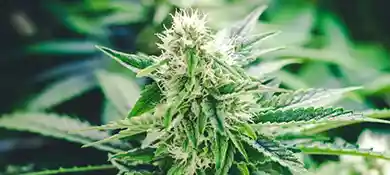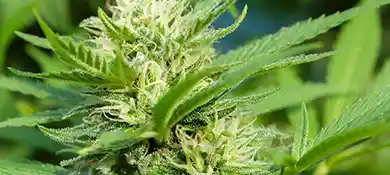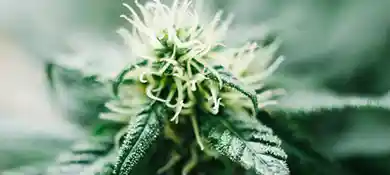Exploring White Spots on Weed Leaves with 6 Illuminating Insights
Occasionally, you may notice white spots on cannabis leaves, which may indicate a problem that needs addressing for your plant to flourish. You may need to address these white spots because there's something underlying.
Identifying the root cause of the white spots is crucial for preventing further damage to your plant. Viruses, pests, and unfavorable environmental conditions are some possibilities. By understanding the cause, you can effectively tackle the problem and keep your plants in pristine condition.

White Spots Caused by Overwatering
Overwatering is a common cause of white spots on weed leaves, which refers to watering plants excessively. It will lead to waterlogged soil and poor root oxygenation, and the roots suffocate and cannot access oxygen, resulting in various growing problems. The roots decay, and the leaves curl, appearing heavy as though something is stuck.
Additionally, overwatering can also cause imbalanced pH levels on the leaves, leading to brown spots. Watering too much can also lead to nutrient deficiencies, such as sulfur or manganese, resulting in yellow leaves or uneven, mottled browning.
In overwatered environments, fungal diseases like powdery mildew, botrytis, and downy mildew thrive, causing white spots.
White Spots Caused by Underwatering
Underwatering is also a common cause of white spots on weed leaves. Sometimes, the plants can't receive enough water to meet their needs because of infrequent watering, low humidity, poor soil quality or other factors. It will lead to stunted growth, wilted leaves, and other symptoms.
Without enough water, the first common symptom is leaf curling, which can also lead to white spots. Second, underwatering plants may also have brittle, papery leaves that break. Third, underwatering can cause brown spots on leaves, which can be mistaken for white spots.
Lastly, it's worth noting that underwatering plants are more vulnerable to fungal diseases like powdery mildew, botrytis, and downy mildew.
White Spots Caused by Nutrient Deficiencies
Nutrient deficiencies are one of the biggest problems cannabis growers face. Insufficient nutrients can negatively affect a cannabis plant's health and growth, causing a variety of problems.
The plants' nutrient deficiencies may include sulfur, phosphorus, calcium, potassium, and others. Too much phosphorus can lock out nutrients like calcium, copper, iron, magnesium, and zinc, preventing the plant from absorbing them.
Dead spots on newer or growing leaves, brown spots, curled or crinkled tips, and stunted growth can all be signs of calcium deficiency. Sulfur deficiency can cause yellow spots on leaves, while phosphorus deficiency can manifest as red or purple stems, brown spots on leaves, and dry leaves. Potassium deficiencies are also a possible cause of white spots.
Poor soil quality, inadequate water management, pH imbalances, and pest infestations can cause nutrient deficiencies in cannabis plants.
White Spots Caused by Fungal and Bacterial Infections
White spots can also be caused by fungal and bacterial infections. These infections can negatively impact the health and productivity of plants. They also spread quickly from one plant to another, we need to catch them and treat them as soon as possible.
The earliest detection and treatment of white spots on cannabis plants is crucial. however, the challenge is to diagnose fungal and bacterial infections early before they develop into more serious issues.
We'd better manage well fungal and bacterial infections to ensure the plants are safe and of high quality. So Implement the effective management strategies, like proper sanitation practices, and prevent the spread of these infections. Keep all equipments clean and disinfected to minimize the risk of fungal and bacterial infections.
White Spots Caused by Pests
White spots on your leaves can be caused by pests, which pose a significant threat to the health of your cannabis plants. There are multiple pests that can infect cannabis plants and cause these white spots. Thrips, spider mites, and fungal gnats are some of the most common pests on cannabis plants. They damage the leaves and reduce productivity and health of plants.
Thrip is a type of insect that resembles worms, and it feed son the leaves and flowers of cannabis plants, stunting their growth, causing discoloration, and other symptoms.
And the spider mite is another common cannabis pest, feeding on the sap, causing discoloration, wilting, and white spots on the leaves. It only takes only a few days to multiply and spread. The fungus gnat can damage the roots of cannabis plants, leading to nutritional deficiencies and other problems.
These pests can also create an entry point for other diseases. So we must identify and control pest infestations as soon as possible to prevent further plant damage.
White Spots Caused by Environmental Factors
Cannabis plants are affected by environmental factors such as temperature and humidity. These factors may also cause white spots on weed leaves in a variety of ways. As an example, high humidity can create an ideal environment for fungal diseases' propagation.
Therefore, it is very critical to control well of environmental factors, such as humidity, temperature and ventilation. We suggest introducing the latest technology, the advanced grow room hvac systems, to maintain optimal humidity, temperature, and ventilation day and night.
Create an ideal indoor climate to prevent fungal diseases, nutrient deficiencies and other issues from arising.
Diagnosis of White Spots on Weed Leaves
From the above introduction, we know that white spots on weed leaves can be caused by different factors. So we must address the underlying cause by careful diagnosis.
For example, if spotting is caused by a fungal disease such as powdery mildew, we need to remove affected leaves and increase air circulation around the plant to prevent further spread.
It is vital to identify the real reason and apply the appropriate treatment. Only by addressing the root cause of white spots, we can prevent further plant damage and get healthy growth promoted.
It is also beneficial to seek professional help when diagnosing white spots on weed leaves. They can determine the cause of white spots and provide appropriate treatment options. Additionally, and you will also get advise on how to prevent the problem from recurring in the future.
Treatment of White Spots on Weed Leaves
It is crucial to treat white spots on weed leaves promptly and effectively to prevent further plant damage and ensure a healthy harvest.
Using insecticides or fungicides effectively treats white spots on cannabis leaves caused by insect or fungal diseases. However, it is vital to use these products sparingly and follow directions carefully to avoid damaging the plant or exposure to harmful chemicals. Soap, or neem oil may be effective.
Adjusting your watering and nutrition schedule can also prevent and treat white spots on cannabis leaves. Overwatering or overwatering stress plants, which makes them more susceptible to fungal diseases and nutrient deficiencies.
If some infections like phytoplasma have no cure, we have to remove the infected plants and nearby weeds.
Prevention of White Spots on Weed Leaves
As we know now, white spots on weed leaves can signify various issues. To prevent these issues, here are several key strategies growers can employ to prevent white spots generated on weed leaves.
First, proper watering is crucial, whether overwatering or underwatering stresses the plant and make it more susceptible to infections. We need to avoid overwatering and ensure that our plants receive the appropriate amount of water and nutrients. And at the same time maintain the proper watering and ensure necessary nutrients to thrive.
Second, appropriate nutrient management is necessary to strengthen plants' immune systems. Regularly monitor nutrient levels and balance the soil and water quality to promote healthy growth. Adjust the feeding regimen as needed to prevent nutrient deficiencies, including enough nutrients.For example, incorporate organic fertilizers and supplements for healthy growth.
Third, proper soil management practices are also imperative, regularly testing soil pH levels and adjusting to ensure the soil is of good quality. Because poor pH levels can result in a nutrient lockout, preventing the plant from absorbing essential nutrients.
Fourth, regularly inspect the plants and prevent pests and infections. Proper pest management techniques help prevent pest infestations and protect the plant from damage, such as using natural insecticides or organic pesticides to control insect populations and prevent the development of white spot disease. Taking proactive action at the first sign of a pest infestation to minimize damage
Finally, maintain proper temperature and humidity levels day and night with the latest grow room hvac system. It can effectively prevent the development of white spots on your cannabis plants and promote healthy growth.
Regular monitoring of the real-time VPD condition from the grow room hvac system, you can create perfect environmental conditions and ensure the long-term health and productivity of your cannabis plants.
Therefore, cannabis growers need to take the above preventative measures and regular monitoring. Just take prompt and suitable action if the problem happens, then you can have the long-term health and productivity of cannabis plants. Just contact our engineers' team if you have any questions or inquiries.
FAQ
1.Why do my weed leaves have white spots?
White spots on weed leaves could be due to pests, nutrient deficiencies, or fungal diseases like powdery mildew. Proper identification is crucial for effective treatment.
2.How do you get rid of white spots on plants?
To get rid of white spots on plants, identify the cause. If it's pests, use an organic insecticide. If it's a fungus, improve airflow, decrease humidity, and consider using a fungicide.
3.Can you get rid of white mold on weed?
You can get rid of white mold on weed. Remove infected parts, improve ventilation, lower humidity, and consider using a fungicide.
Share with your friends:
Popular Blogs on Altaqua:
Get HVAC Brochure?
Get HVAC Brochure?



